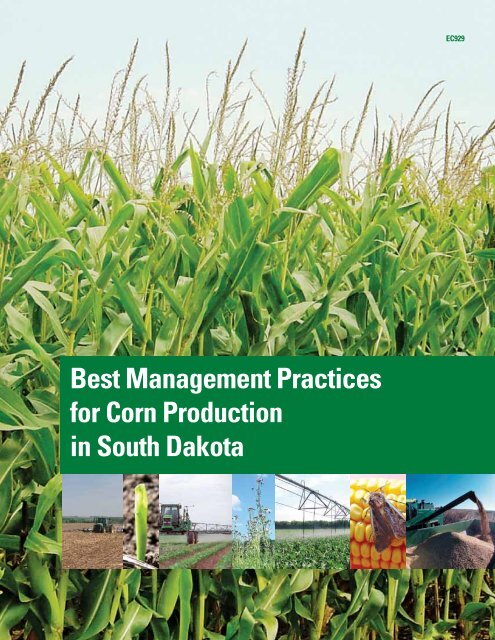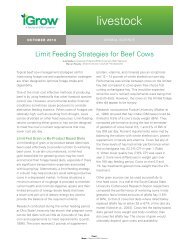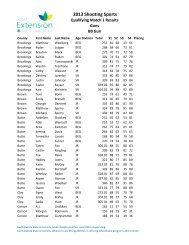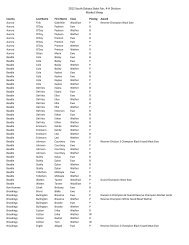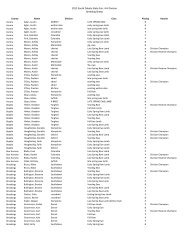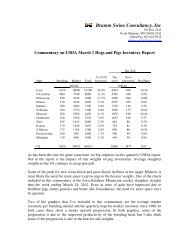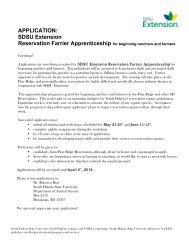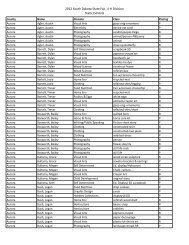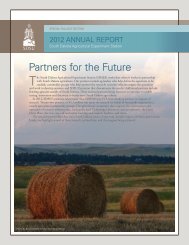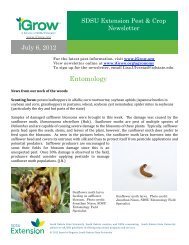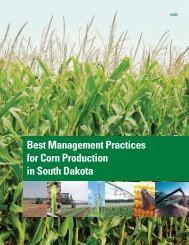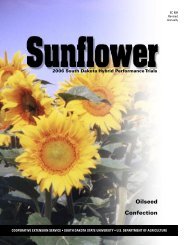Chapter 2 - Corn Hybrid Selection - iGrow
Chapter 2 - Corn Hybrid Selection - iGrow
Chapter 2 - Corn Hybrid Selection - iGrow
You also want an ePaper? Increase the reach of your titles
YUMPU automatically turns print PDFs into web optimized ePapers that Google loves.
Best Management Practices<br />
for <strong>Corn</strong> Production<br />
in South Dakota<br />
EC929
Best Management Practices<br />
for <strong>Corn</strong> Production<br />
in South Dakota<br />
®<br />
South Dakota State University is an Affirmative Action/Equal Opportunity<br />
Employer and offers all benefits, services, education, and employment<br />
without regard for race, color, creed, religion, national origin, ancestry,<br />
citizenship, age, gender, sexual orientation, disability, or Vietnam Era<br />
veteran status.<br />
––––––––––––––––––––––––––––––––––––––––––––––––––––––––––––––––––––––––––––––––––––––<br />
Support for this document was provided by South Dakota State University, South Dakota Cooperative<br />
Extension Service, South Dakota Agricultural Experiment Station; South Dakota <strong>Corn</strong> Utilization<br />
Council; USDA-CSREES-406; South Dakota Department of Environment and Natural Resources<br />
through EPA-319; South Dakota USGS Water Resources Institute; USDA-North Central Region SARE<br />
program; Colorado <strong>Corn</strong> Growers Association; and Colorado State University.<br />
––––––––––––––––––––––––––––––––––––––––––––––––––––––––––––––––––––––––––––––––––––––<br />
Published by South Dakota State University, College of Agriculture and Biological Sciences,<br />
AgBio Communications Unit, Box 2218A, Brookings, South Dakota 57007<br />
© 2009 by South Dakota State University, Brookings, South Dakota<br />
All rights reserved, including the right to reproduce any part of this book in any form, except brief<br />
quotations, without premission of the publisher.<br />
––––––––––––––––––––––––––––––––––––––––––––––––––––––––––––––––––––––––––––––––––––––<br />
EC929. 2,000 copies printed and distributed by South Dakota Cooperative Extension Service at a cost of<br />
$8.68 each. May 2009.
ii<br />
About 5 million acres of South Dakota land—close to 10% of<br />
our state’s land resources—are devoted to corn production. This<br />
fact alone makes it clear just how important corn production is<br />
to the economy of the state of South Dakota. But throw in recent<br />
developments in South Dakota’s corn-based ethanol industry, and<br />
the result is an even further elevation of corn—an elevation to a<br />
most prominent position within the economy of our state.<br />
For the last century, the intensity of farming management has<br />
continued to escalate. This best management practices manual has<br />
brought together some of the best of both old and new technology.<br />
It is my belief that this manual will be a significant<br />
reference and resource for every South Dakota corn producer.<br />
To all who participated in the development of Best Management Practices for <strong>Corn</strong><br />
Production in South Dakota, I both extend my appreciation and offer a commendation<br />
for a job well done.<br />
Latif Lighari, Ph.D.<br />
Associate Dean and Director<br />
South Dakota State University<br />
South Dakota Cooperative Extension Service<br />
Professor of Agricultural Education<br />
College of Agriculture and Biological Sciences<br />
South Dakota corn producers are some of the most productive<br />
in the nation. Our state ranked sixth in the nation in production<br />
of corn for grain in 2007 and has led the nation in planted acres of<br />
genetically engineered corn hybrids since 2000. And yet, our corn<br />
producers face many challenges each year. Each producer must<br />
make the best decision on which corn hybrid to plant, choose the<br />
best fertilizer program, manage high input costs, expect seasonal<br />
hazards, deal with weeds and pests, and market the harvest for the<br />
greatest profit.<br />
This manual presents the best management practices developed<br />
for the changing environment of corn production agriculture<br />
in South Dakota. From detailed, basic information on<br />
corn growth and development, through each phase of the corn<br />
production process, the authors and contributors have provided corn producers with an<br />
up-to-date and invaluable reference tool.<br />
I extend my congratulations to the editors, reviewers, authors, and contributors for<br />
a job well done.<br />
Bill Even<br />
South Dakota Secretary of Agriculture
Editors<br />
David E. Clay, Kurtis D. Reitsma, and Sharon A. Clay<br />
Plant Science Department, South Dakota State University<br />
Brookings, South Dakota 57007<br />
For information, contact david.clay@sdstate.edu.<br />
Coordination, Manuscript Editing, and Graphic Design<br />
Eric Ollila , Publication Coordinator-Editor<br />
Terry Molengraaf, Information Officer<br />
AgBio Communications Unit<br />
College of Agriculture and Biological Sciences, South Dakota State University<br />
Brookings, South Dakota 57007<br />
Reviewers, Authors, and Contributors (alphabetical order)<br />
Troy Bauder, Research Scientist Department of Soil & Crop Science, Colorado State University<br />
Dwayne L. Beck, Research Manager Dakota Lakes Research Farm, South Dakota State University<br />
Sue L. Blodgett, Department Head Plant Science Department, South Dakota State University<br />
C. Gregg Carlson, Agronomist Plant Science Department, South Dakota State University<br />
Michael A. Catangui, Entomologist Cooperative Extension Service, South Dakota State University<br />
David E. Clay, Soil Scientist Plant Science Department, South Dakota State University<br />
Sharon A. Clay, Weed Scientist Plant Science Department, South Dakota State University<br />
Darrell L. Deneke, IPM Specialist Cooperative Extension Service, South Dakota State University<br />
Martin A. Draper, Plant Pathologist Cooperative State Research, Education, and Extension Service<br />
B. Wade French, Entomologist Agricultural Research Service, United States Department of Agriculture<br />
Billy W. Fuller, Entomologist Plant Science Department, South Dakota State University<br />
Robert G. Hall, Agronomist Cooperative Extension Service, South Dakota State University<br />
Curt A. Hoffbeck, Agronomist Pioneer Hi-Bred International<br />
Daniel S. Humburg, Biosystems Engineer Agricultural and Biosystems Engineering Dept., South Dakota State University<br />
Marie A. Langham, Plant Pathologist Plant Science Department, South Dakota State University<br />
Douglas D. Malo, Soil Scientist Plant Science Department, South Dakota State University<br />
Mike J. Moechnig, Weed Scientist Cooperative Extension Service, South Dakota State University<br />
Richard E. Nicolai, Biosystems Engineer Agricultural and Biosystems Engineering Dept., South Dakota State University<br />
Kurtis D. Reitsma, Agronomist Plant Science Department, South Dakota State University<br />
Bradley E. Ruden, Plant Pathologist Plant Diagnostic Clinic, South Dakota State University<br />
Thomas E. Schumacher, Soil Scientist Plant Science Department, South Dakota State University<br />
Dennis P. Todey, Climatologist State Climate Office, South Dakota State University<br />
Todd P. Trooien, Biosystems Engineer Agricultural and Biosystems Engineering Dept., South Dakota State University<br />
Hal D. Werner, Biosystems Engineer Agricultural and Biosystems Engineering Dept., South Dakota State University<br />
James A. Wilson, Pesticide Specialist Cooperative Extension Service, South Dakota State University<br />
Howard J. Woodard, Soil Scientist Plant Science Department, South Dakota State University<br />
Leon J. Wrage, Weed Scientist Plant Science Department, South Dakota State University<br />
Recognition and Acknowledgements:<br />
South Dakota <strong>Corn</strong> Utilization Council<br />
South Dakota Department of Agriculture<br />
South Dakota Department of Environment and Natural Resources<br />
Cover photos: USDA-NRCS and Kurtis D. Reitsma.<br />
iii
CHAPTER 2<br />
<strong>Corn</strong> <strong>Hybrid</strong> <strong>Selection</strong><br />
Selecting a hybrid is one of the most important decisions a<br />
producer makes. <strong>Hybrid</strong> selection should consider yield, maturity,<br />
resistance to disease and insect pests, and other traits important to<br />
individual production systems (Table 2.1).<br />
<strong>Hybrid</strong> Maturity<br />
Growing-season length varies within South Dakota. Growers<br />
are encouraged to select hybrids that will reach physiological maturity,<br />
or “black layer,” about 1 to 2 weeks before the average first killing<br />
frost. Comparing the maturity rating systems of different seed<br />
companies is difficult because the respective ratings systems are<br />
estimated and reported differently. One commonly used system is<br />
the Minnesota Relative Maturity (MRM) system. In the MRM system<br />
the hybrid is field tested for 3 years and compared to a group<br />
of standard hybrids with known relative maturities (RM). <strong>Hybrid</strong>s<br />
with relative maturity ratings ranging from 75 to 115 days are suitable for South Dakota.<br />
Another approach for selecting hybrids relies on accumulated “growing degree days” (GDD) or<br />
“growing degree units” (GDU). The base temperature used for calculating GDUs will vary by crop. The<br />
base temperature for corn is 50°F (corn growth is minimal below this temperature). The maximum<br />
temperature used also varies by crop; for corn it is set at 86°F (corn growth declines when the temperature<br />
exceeds 86°F). GDUs are calculated using the equation in Table 2.2. Accumulation of GDUs can be<br />
tracked with a thermometer during the growing season or is available for specific South Dakota sites at<br />
http://climate.sdstate.edu/climate_site/current_weather.htm.<br />
When using GDUs to select hybrids, base the maturity selection on accumulated GDUs from plant-<br />
ing to first fall frost (minus<br />
the adjustment value of GDUs<br />
to allow for grain dry-down).<br />
However, if the crop is to be<br />
harvested for silage, an allowance<br />
for grain dry-down is not<br />
needed. If planting is delayed,<br />
an earlier-maturing hybrid<br />
may be appropriate. Average<br />
accumulated GDUs for selected<br />
spring planting dates is provided<br />
by location in Table 2.3.<br />
Table 2.2. Calculation of growing degree units (GDUs)<br />
1 <br />
<br />
2<br />
Table 2.1. Common traits for<br />
evaluating a hybrid<br />
<br />
<br />
<br />
<br />
<br />
<br />
<br />
<br />
<br />
<br />
<br />
2 <br />
3 <br />
4 <br />
1 <br />
<br />
2 <br />
3 <br />
4 <br />
CHAPTER 2: <strong>Corn</strong> <strong>Hybrid</strong> <strong>Selection</strong> 9
10<br />
Table 2.3. Average accumulated growing degree units (*GDUs)<br />
<br />
Weather Station<br />
Aberdeen Arprt<br />
Armour<br />
Bison<br />
Bridgewater<br />
Britton<br />
Brookings 2 NE**<br />
<br />
<br />
<br />
<br />
De Smet<br />
Eureka<br />
Faith<br />
Faulkton 1 NW<br />
Flandreau<br />
Gettysburg<br />
Gregory<br />
<br />
<br />
<br />
Kennebec<br />
Madison 2 SE<br />
Mellette<br />
Menno<br />
Milbank 2 SSW<br />
Miller<br />
Mission<br />
Mitchell 2 N<br />
Newell<br />
Oelrichs<br />
Onida 4 NW<br />
Pollock<br />
<br />
Redfield 2 NE<br />
Selby<br />
Sioux Falls Arprt<br />
Sisseton<br />
Timber Lake<br />
Tyndall<br />
Vermillion 2 SE<br />
Wagner<br />
Watertown Arprt<br />
Webster<br />
Wessington Springs<br />
Winner<br />
CHAPTER 2: <strong>Corn</strong> <strong>Hybrid</strong> <strong>Selection</strong><br />
<br />
of<br />
data<br />
36<br />
32<br />
29<br />
29<br />
35<br />
36<br />
31<br />
36<br />
35<br />
34<br />
33<br />
36<br />
30<br />
33<br />
34<br />
33<br />
35<br />
30<br />
36<br />
35<br />
35<br />
36<br />
31<br />
35<br />
28<br />
35<br />
35<br />
29<br />
35<br />
35<br />
34<br />
31<br />
29<br />
26<br />
35<br />
35<br />
35<br />
36<br />
34<br />
27<br />
36<br />
32<br />
34<br />
34<br />
35<br />
May<br />
1<br />
2,389<br />
2,832<br />
2,326<br />
2,720<br />
2,523<br />
2,220<br />
2,687<br />
2,554<br />
2,441<br />
2,390<br />
2,572<br />
2,299<br />
2,503<br />
2,454<br />
2,332<br />
2,320<br />
2,682<br />
2,531<br />
2,564<br />
2,327<br />
2,754<br />
2,427<br />
2,381<br />
2,802<br />
2,426<br />
2,596<br />
2,439<br />
2,718<br />
2,337<br />
2,447<br />
2,573<br />
2,470<br />
2,340<br />
2,399<br />
2,323<br />
2,592<br />
2,456<br />
2,411<br />
2,859<br />
2,895<br />
2,974<br />
2,344<br />
2,415<br />
2,814<br />
2,906<br />
May<br />
11<br />
Spring planting date Adjustment<br />
May<br />
21<br />
May<br />
31<br />
June<br />
10<br />
June<br />
20<br />
for grain<br />
dry-down<br />
Average date of<br />
first fall frost<br />
average GDUs † to first fall frost of 32°F GDUs ‡ 32°F 28°F<br />
2,305<br />
2,730<br />
2,243<br />
2,627<br />
2,427<br />
2,149<br />
2,589<br />
2,464<br />
2,363<br />
2,308<br />
2,485<br />
2,218<br />
2,416<br />
2,368<br />
2,254<br />
2,245<br />
2,586<br />
2,440<br />
2,475<br />
2,242<br />
2,650<br />
2,348<br />
2,299<br />
2,697<br />
2,344<br />
2,507<br />
2,362<br />
2,627<br />
2,265<br />
2,360<br />
2,480<br />
2,379<br />
2,268<br />
2,312<br />
2,247<br />
2,501<br />
2,369<br />
2,328<br />
2,760<br />
2,796<br />
2,863<br />
2,266<br />
2,333<br />
2,729<br />
2,800<br />
2,195<br />
2,599<br />
2,143<br />
2,507<br />
2,308<br />
2,052<br />
2,458<br />
2,348<br />
2,259<br />
2,203<br />
2,376<br />
2,114<br />
2,307<br />
2,264<br />
2,152<br />
2,144<br />
2,464<br />
2,322<br />
2,363<br />
2,131<br />
2,520<br />
2,242<br />
2,192<br />
2,566<br />
2,233<br />
2,393<br />
2,261<br />
2,509<br />
2,170<br />
2,252<br />
2,363<br />
2,265<br />
2,171<br />
2,204<br />
2,144<br />
2,387<br />
2,256<br />
2,222<br />
2,636<br />
2,646<br />
2,728<br />
2,163<br />
2,227<br />
2,612<br />
2,668<br />
2,072<br />
2,458<br />
2,038<br />
2,365<br />
2,176<br />
1,938<br />
2,316<br />
2,213<br />
2,142<br />
2,083<br />
2,254<br />
1,996<br />
2,191<br />
2,143<br />
2,031<br />
2,044<br />
2,336<br />
2,195<br />
2,235<br />
2,010<br />
2,382<br />
2,119<br />
2,077<br />
2,418<br />
2,108<br />
2,270<br />
2,148<br />
2,377<br />
2,056<br />
2,134<br />
2,236<br />
2,136<br />
2,069<br />
2,080<br />
2,030<br />
2,254<br />
2,132<br />
2,105<br />
2,493<br />
2,496<br />
2,576<br />
2,046<br />
2,105<br />
2,475<br />
2,529<br />
1,928<br />
2,296<br />
1,906<br />
2,202<br />
2,021<br />
1,803<br />
2,153<br />
2,054<br />
2,002<br />
1,944<br />
2,105<br />
1,859<br />
2,052<br />
1,996<br />
1,889<br />
1,913<br />
2,180<br />
2,043<br />
2,084<br />
1,869<br />
2,215<br />
1,973<br />
1,933<br />
2,247<br />
1,956<br />
2,120<br />
2,012<br />
2,217<br />
1,927<br />
1,994<br />
2,085<br />
1,985<br />
1,941<br />
1,935<br />
1,896<br />
2,098<br />
1,983<br />
1,193<br />
2,328<br />
2,318<br />
2,400<br />
1,904<br />
1,964<br />
2,314<br />
2,362<br />
1,763<br />
2,104<br />
1,756<br />
2,010<br />
1,847<br />
1,644<br />
1,960<br />
1,868<br />
1,839<br />
1,777<br />
1,930<br />
1,704<br />
1,894<br />
1,834<br />
1,724<br />
1,758<br />
2,000<br />
1,870<br />
1,907<br />
1,708<br />
2,025<br />
1,805<br />
1,766<br />
2,050<br />
1,789<br />
1,947<br />
1,850<br />
2,030<br />
1,778<br />
1,834<br />
1,916<br />
1,821<br />
1,793<br />
1,770<br />
1,738<br />
1,912<br />
1,814<br />
1,803<br />
2,132<br />
2,114<br />
2,200<br />
1,741<br />
1,804<br />
2,129<br />
2,170<br />
163<br />
330<br />
199<br />
278<br />
192<br />
143<br />
250<br />
212<br />
224<br />
218<br />
250<br />
162<br />
268<br />
213<br />
199<br />
237<br />
273<br />
207<br />
237<br />
158<br />
230<br />
214<br />
187<br />
271<br />
220<br />
266<br />
236<br />
287<br />
229<br />
220<br />
246<br />
225<br />
247<br />
196<br />
188<br />
245<br />
237<br />
252<br />
334<br />
327<br />
363<br />
155<br />
214<br />
366<br />
385<br />
Sep 22<br />
Sep 30<br />
Sep 25<br />
Oct 1<br />
Sep 24<br />
Sep 21<br />
Sep 27<br />
Sep 24<br />
Sep 30<br />
Sep 29<br />
Sep 30<br />
Sep 22<br />
Sep 28<br />
Sep 25<br />
Sep 26<br />
Sep 28<br />
Sep 29<br />
Sep 24<br />
Sep 27<br />
Sep 22<br />
Sep 24<br />
Sep 27<br />
Sep 24<br />
Sep 27<br />
Sep 27<br />
Oct 1<br />
Sep 26<br />
Oct 1<br />
Sep 26<br />
Sep 24<br />
Sep 27<br />
Sep 26<br />
Sep 30<br />
Sep 23<br />
Sep 25<br />
Sep 28<br />
Sep 29<br />
Sep 29<br />
Oct 3<br />
Sep 29<br />
Oct 3<br />
Sep 23<br />
Sep 29<br />
Oct 5<br />
Oct 3<br />
Oct 1<br />
Oct 21<br />
Oct 15<br />
Oct 22<br />
Oct 10<br />
Oct 11<br />
Oct 16<br />
Oct 18<br />
Oct 15<br />
Oct 17<br />
Oct 17<br />
Oct 9<br />
Oct 16<br />
Oct 10<br />
Oct 14<br />
Oct 15<br />
Oct 19<br />
Oct 12<br />
Oct 18<br />
Oct 8<br />
Oct 11<br />
Oct 19<br />
Oct 10<br />
Oct 19<br />
Oct 17<br />
Oct 15<br />
Oct 13<br />
Oct 22<br />
Oct 14<br />
Oct 11<br />
Oct 15<br />
Oct 7<br />
Oct 24<br />
Oct 11<br />
Oct 11<br />
Oct 20<br />
Oct 18<br />
Oct 13<br />
Oct 22<br />
Oct 24<br />
Oct 25<br />
Oct 11<br />
Oct 14<br />
Oct 27<br />
Oct 23<br />
* GDUs – based on a daily maximum and minimum of 86 o F and 50 o F, respectively, and a base temperature of 50° F (Table 2.2).<br />
<br />
‡ GDUs that must be subtracted from any May 1 to June 20 date to allow for 10 days of dry-down before 32°F.<br />
<br />
and greater than the average; therefore, values lower or higher than average should be expected.<br />
Adapted from Todey, D. and C. Shukla. 2007. South Dakota Climate & Weather. South Dakota State University.
The map in figure 2.1 shows<br />
the 30-year average accumulated<br />
GDUs (50°F basis) across the<br />
state during an “average” growing<br />
season (taking into account the<br />
probabilities of the last spring and<br />
first fall frost dates).<br />
A third approach to hybrid<br />
maturity selection is the Comparative<br />
Relative Maturity (CRM)<br />
method. With this method, RM<br />
and GDUs are compared. No<br />
matter which method is selected,<br />
the most important factor for<br />
achieving the full genetic yield<br />
potential is to choose hybrids that<br />
are suited to local conditions.<br />
<strong>Hybrid</strong>s that have either too long<br />
or short maturity may not reach<br />
their full yield potential. Growers<br />
are advised to consult their<br />
local county Extension educator<br />
or crop advisor to assist them in<br />
hybrid selection.<br />
Figure 2.1. Thirty-year average accumulated GDUs (50°F basis)<br />
Accumulated GDUs<br />
<br />
Observer Stations, considering the 50th percentile date of last spring frost and<br />
first fall frost for each reporting station between 1977 and 2006.<br />
Yield Potential and Stability<br />
Regardless of climate, fertility, pest, or weed problems, different hybrids have different yield potentials.<br />
<strong>Hybrid</strong>s that are more resistant to stress have more stable yields. When considering a hybrid, yield<br />
data and climate conditions for the past 3 years should be considered. <strong>Hybrid</strong>s with consistent yields<br />
under varying climate conditions are more desirable than hybrids with variable yields.<br />
Another approach is to plant 15, 35, and 50% of acres with hybrids having 1, 2, and 3 years of yield<br />
data, respectively. This allows a producer to take advantage of a new hybrid without exceptional risk.<br />
<strong>Corn</strong> yield trials are conducted annually by the South Dakota State<br />
University Crop Performance Testing Program. Results from those<br />
yield trials are available at http://plantsci.sdstate.edu/varietytrials/.<br />
Table 2.4. Agronomic traits<br />
Agronomic Traits<br />
Agronomic traits represent the base genetics of the hybrid. Seed<br />
companies commonly rate the hybrid’s yield, stalk strength, drought<br />
tolerance, and disease-resistance traits. One trait may be more important<br />
to a producer than another.<br />
Emergence and seedling vigor indicate the ability of the plant to<br />
deal with stress early in the season. <strong>Hybrid</strong>s that emerge quicker and<br />
have a greater early season vigor may be able to better cope with cool<br />
temperatures. This is especially important in high-residue no-tillage<br />
systems.<br />
Harvestability is related to traits that impact dry-down rate, root<br />
and stalk strength, “stay-green,” ear retention, and husk cover. Lodging<br />
and ear-drop can reduce yield simply by making it difficult to harvest<br />
the crop. Plants that stay green later into the season are likely to have<br />
Plant Development<br />
<br />
<br />
<br />
<br />
<br />
<br />
<br />
<br />
<br />
<br />
<br />
<br />
<br />
<br />
CHAPTER 2: <strong>Corn</strong> <strong>Hybrid</strong> <strong>Selection</strong> 11
12<br />
increased stalk strength and reduced lodging. Ear retention indicates how strongly the plant holds the<br />
ear and resists ear-drop.<br />
Although a hybrid might have a good genetic package for plant standability, there is no guarantee<br />
that it will not lodge or break. All hybrids are susceptible to stalk lodging, snapping, or breakage during<br />
periods of rapid stalk growth. <strong>Hybrid</strong>s prone to stalk breakage have a longer period of susceptibility or<br />
exhibit a greater degree of damage during rapid growth. Strong winds, hail, insect damage, and stalk<br />
rots (exacerbated by insect damage and/or drought) can cause stalk breakage. Growth-regulator herbicides<br />
like 2,4-D and dicamba can affect a hybrid’s ability to resist stalk problems.<br />
Insect and Disease Resistance and Genetically Modified Crops<br />
If disease or insect problems exist or are expected, resistance traits for that particular pest are important.<br />
To identify resistance to specific problems, check with your seed dealer.<br />
Genetically modified crops (GMC) have become popular for managing insect and weed pests. Insects<br />
that present a threat to the crop (such as European corn borer, corn rootworm, and western bean<br />
cutworm) can be controlled by planting a hybrid genetically engineered to kill those insects. Genetically<br />
engineered hybrids that are tolerant to broad-spectrum herbicides can simplify weed control programs.<br />
It is recommended that the technology cost and marketability of the crop be considered prior to committing<br />
to a GMC. Information regarding GMC-approval status is available from the National <strong>Corn</strong><br />
Growers Association (NCGA) online at http://www.ncga.com/biotechnology/main/index.asp.<br />
Seed Quality<br />
Prior to planting, seed should be checked for germination rates and weed seeds. Weed seed is generally<br />
not a problem, due to the large seed size and ease of weed seed removal with mechanical seed-conditioning<br />
equipment. All hybrid seed must have germination test results on the label. Cold test germination<br />
values of 85% or higher are desirable if planting in soil with temperatures less than 50°F. Most<br />
hybrid seed is treated with a fungicide. Seed should be inspected for nicks or cracks, as these conditions<br />
lower seed quality (thus increasing vulnerability to disease infection). Broken or cracked seeds may not<br />
germinate; poor quality seed should be returned to the dealer.<br />
Additional Information and References<br />
Hall, R.G. and K.K. Kirby. 2007 (revised annually). Precision planted corn performance trials.<br />
South Dakota State University, South Dakota Cooperative Extension Service, Brookings, SD. http://<br />
agbiopubs.sdstate.edu.<br />
Todey, D. and C. Shukla. 2007. South Dakota climate and weather. South Dakota State University.<br />
http://climate.sdstate.edu/climate.<br />
––––––––––––––––––––––––––––––––––––––––––––––––––––––––––––––––––––––––––––––––––––––<br />
Hall, R.G. and K.D. Reitsma. 2009. “<strong>Corn</strong> hybrid selection.” Pp. 9–12. In Clay, D.E., K.D. Reitsma, and<br />
S.A, Clay (eds). Best Management Practices for <strong>Corn</strong> Production in South Dakota. EC929. South<br />
Dakota State University, South Dakota Cooperative Extension Service, Brookings, SD.<br />
Support for this document was provided by South Dakota State University, South Dakota Cooperative<br />
Extension Service, South Dakota Agricultural Experiment Station; South Dakota <strong>Corn</strong> Utilization<br />
Council; USDA-CSREES-406; South Dakota Department of Environment and Natural Resources<br />
through EPA-319; South Dakota USGS Water Resources Institute; USDA-North Central Region SARE<br />
program; Colorado <strong>Corn</strong> Growers Association; and Colorado State University.<br />
The information in this chapter is provided for educational purposes only. Product trade names<br />
have been used for clarity. Any reference to trade names does not imply endorsement by South Dakota<br />
State University, nor is any discrimination intended against any product, manufacturer, or distributor.<br />
The reader is urged to exercise caution in making purchases or evaluating product information.<br />
CHAPTER 2: <strong>Corn</strong> <strong>Hybrid</strong> <strong>Selection</strong>


